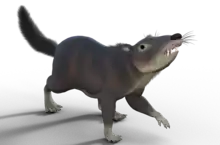Peramus
Peramus is an extinct genus of cladotherian mammal. It lived in the Late Jurassic and Early Cretaceous of Europe and North Africa.
| Peramus | |
|---|---|
 | |
| Peramus tenuirostris NHMUK PV OR 47742 | |
| Scientific classification | |
| Kingdom: | Animalia |
| Phylum: | Chordata |
| Class: | Mammalia |
| Order: | †Peramura |
| Family: | †Peramuridae |
| Genus: | †Peramus Owen, 1871 |
Species
There are three known extinct species in the genus:[1]
- Peramus dubius Lulworth Formation, United Kingdom, Berriasian
- Peramus minor Lulworth Formation, United Kingdom, Berriasian
- Peramus tenuirostris Lulworth Formation, United Kingdom, Berriasian
Additionally, indeterminate remains are known from the Ksar Metlili Formation of Morocco, dating to the Tithonian-Berriasian.
Phylogeny
Peramus is generally considered an advanced cladotherian. In the analysis performed by Panciroli and colleagues (2018), Peramus was recovered as within a clade also including Palaeoxonodon and Amphitherium, as derived members of Cladotheria. Peramus, Palaeoxonodon and Amphitherium were united by the shared traits of "convergence of the Meckel’s sulcus with the ventral border of the mandible; and possessing open rooted postcanines." but the placement of Peramus as a more advanced cladotherian cannot be ruled out.[2] In a 2018 analysis by Bi and colleagues, Peramus was recovered in a clade with Palaeoxonodon and Nanolestes also as advanced cladotherians.[3]
References
- "Fossilworks: Peramus". fossilworks.org. Retrieved 2020-01-29.
- "New partial dentaries of amphitheriid mammalian Palaeoxonodon ooliticus from Scotland, and posterior dentary morphology in early cladotherians - Acta Palaeontologica Polonica". www.app.pan.pl. Retrieved 2021-02-08.
- Bi, Shundong; Zheng, Xiaoting; Wang, Xiaoli; Cignetti, Natalie E.; Yang, Shiling; Wible, John R. (June 2018). "An Early Cretaceous eutherian and the placental–marsupial dichotomy". Nature. 558 (7710): 390–395. doi:10.1038/s41586-018-0210-3. ISSN 1476-4687.





